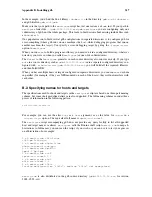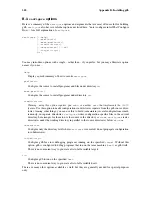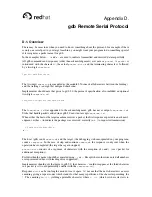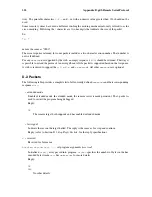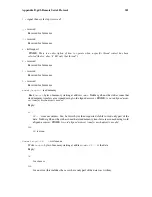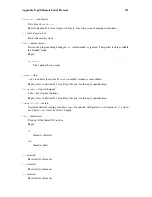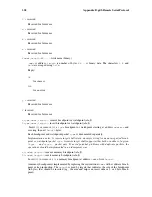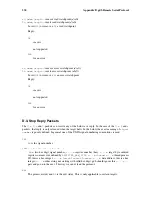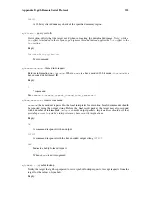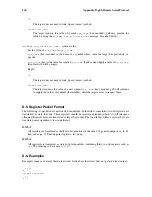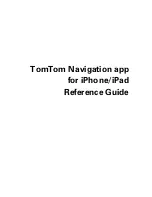
Appendix D. gdb Remote Serial Protocol
331
X
AA
The process terminated with signal
AA
.
N
AA
;
t...
;
d...
;
b...
(obsolete)
AA
= signal number;
t...
= address of symbol
_start
;
d...
= base of data section;
b...
=
base of bss section.
Note: only used by Cisco Systems targets. The difference between this reply
and the
qOffsets
query is that the
N
packet may arrive spontaneously whereas the
qOffsets
is a query initiated by the host debugger.
O
XX...
XX...
is hex encoding of ascii data. This can happen at any time while the program is running
and the debugger should continue to wait for
W
,
T
, etc.
F
call-id,parameter...
call-id
is the identifier which says which host system call should be called. This is just the
name of the function. Translation into the correct system call is only applicable as it’s defined in
gdb. Refer to Section D.7
File-I/O remote protocol extension
, for a list of implemented system
calls.
parameter...
is a list of parameters as defined for this very system call.
The target replies with this packet when it expects gdb to call a host system call on behalf of the
target. gdb replies with an appropriate
F
packet and keeps up waiting for the next reply packet
from the target. The latest
C
,
c
,
S
or
s
action is expected to be continued. Refer to Section D.7
File-I/O remote protocol extension
, for more details.
D.4. General Query Packets
The following set and query packets have already been defined.
qC
-- current thread
Return the current thread id.
Reply:
QCpid
Where
pid
is a HEX encoded 16 bit process id.
*
Any other reply implies the old pid.
qfThreadInfo
- all thread ids
qsThreadInfo
Obtain a list of active thread ids from the target (OS). Since there may be too many active
threads to fit into one reply packet, this query works iteratively: it may require more than one
query/reply sequence to obtain the entire list of threads. The first query of the sequence will be
the
qfThreadInfo
query; subsequent queries in the sequence will be the
qsThreadInfo
query.
NOTE: replaces the
qL
query (see below).
Summary of Contents for ENTERPRISE LINUX 3 - SECURITY GUIDE
Page 1: ...Red Hat Enterprise Linux 3 Debugging with gdb ...
Page 12: ...2 Chapter 1 Debugging with gdb ...
Page 28: ...18 Chapter 4 Getting In and Out of gdb ...
Page 34: ...24 Chapter 5 gdb Commands ...
Page 44: ...34 Chapter 6 Running Programs Under gdb ...
Page 68: ...58 Chapter 8 Examining the Stack ...
Page 98: ...88 Chapter 10 Examining Data ...
Page 112: ...102 Chapter 12 Tracepoints ...
Page 118: ...108 Chapter 13 Debugging Programs That Use Overlays ...
Page 138: ...128 Chapter 14 Using gdb with Different Languages ...
Page 144: ...134 Chapter 15 Examining the Symbol Table ...
Page 170: ...160 Chapter 19 Debugging remote programs ...
Page 198: ...188 Chapter 21 Controlling gdb ...
Page 204: ...194 Chapter 22 Canned Sequences of Commands ...
Page 206: ...196 Chapter 23 Command Interpreters ...
Page 216: ...206 Chapter 25 Using gdb under gnu Emacs ...
Page 296: ...286 Chapter 27 gdb Annotations ...
Page 300: ...290 Chapter 28 Reporting Bugs in gdb ...
Page 322: ...312 Chapter 30 Using History Interactively ...
Page 362: ...352 Appendix D gdb Remote Serial Protocol ...
Page 380: ...370 Appendix F GNU GENERAL PUBLIC LICENSE ...
Page 386: ...376 Appendix G GNU Free Documentation License ...
Page 410: ......

